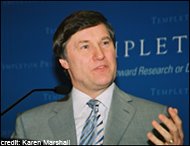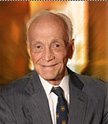Predicting Nothing and Next - to - Nothing: A Nobel Thought
 Tuesday, December 12, 2006
Tuesday, December 12, 2006 
Temperature fluctuations in CMB. Click to enlarge.John Mather and George Smoot were named winners of the 2006 Nobel Prize in Physics this past month. Their work on the NASA Cosmic Background Explorer (COBE) is primarily experimental. The accuracy of their instruments and subsequent precision of their results are remarkable achievements.
What the measurements imply is even more remarkable, and is a great example of the deep interplay between understanding and prediction that happens when things break the right way, when theory and experiment mutually reinforce each other illuminating a deep secret about the universe. ( Hence the Nobel prize...)
Mather and Smoot were checking on the two major predictions of inflationary Big Bang theory:
- The cosmic microwave background (CMB) - a measure of the intensity of radiation present in the universe as a function of wavelength. Theory predicted that the measured radiation should follow an almost-perfect blackbody spectrum. (i.e. should follow the mathematical form first determined by Planck in 1900 - the beginning of Quantum Mechanics). The major parameter used to fit CMB to a blackbody spectrum is temperature, hence finding an experimental blackbody curve can be a very accurate thermometer
- The temperature of the CMB should vary very slightly for different portions of the sky, i.e. the universe. It is only with these fluctuations that inflationary theory predicts the eventual clumping of interstellar matter to form stars, proto-galaxies and ultimately the solar system and planets.

Measured vs. Theoretical CMB. Click to enlarge.Click on the graph to the left to see a fit that's "almost perfect" It is a graph of the experimentally measured spectrum superimposed on a black body function. The size of the data squares represent the uncertainties in measurement. The fit is astonishingly good - as perfect a fit as has ever been seen in an experiment as complex as the COBE. So the first piece of the puzzle came in as desired. What about the temperature fluctuations?
The figure at the top of this post shows the temperature variation of the CMB over a certain region of the sky. Mather and Smoot measured incredibly tiny temperature variations - approx. 30 microkelvin, again, in line with theory.
So the Nobel goes to experimenters who measured "nothing" - i.e. no measurable deviation from a perfect black-body spectrum, and next-to-nothing - temperature variations so miniscule that a few clusters of atoms moving with slightly different velocities would throw off the results.
What to make of these results? By themselves, the results are merely facts - interesting facts, to be sure, but simply facts. It is only in coordination with theoretical predictions that these facts come alive - stating for all that there is something to the theory in the first place. And, because of that very positive reinforcement, the data+theory yields an understanding about the universe that is much deeper, and stronger, than at any other stage in the history of the cosmological beliefs of Earth's inhabitants.













